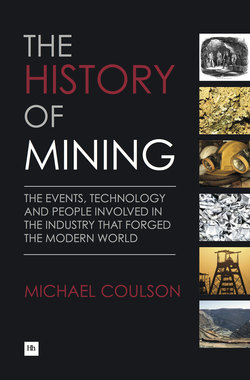Читать книгу The History of Mining - Michael Coulson - Страница 19
На сайте Литреса книга снята с продажи.
Persia, the Empire and Iran
ОглавлениеIn the 7th century BC Persia emerged as a major power in the Middle and Near East and in due course its influence extended both east towards India and also further into the Mediterranean, where it often clashed with Greece. Gold was an important factor in Persia’s expansion as it provided the Empire with a legitimate monetary system which supported its political ambitions. Persia’s gold came from both wealth acquired as a result of conquest and from mines which came under its control. This wealth in gold was always useful, as Persia’s major rival at the time, Greece, was rich in the less valuable silver but had limited access to gold. Thus Persia found it was able to buy influence in the eastern Mediterranean without the need for military successes, which was fortunate, as its few sallies forth against the Greeks had singularly failed to achieve anything.
Persia’s gold came from mines in both Asia and the Middle East, its empire stretching from India and the modern -stans of central Asia, through Iran to the Arabian peninsular. Much of the Empire’s gold was mined as alluvial gold washed down from the mountains of Anatolia (Turkey) in the west and of Bactria (Uzbekistan) in the east. Apart from using gold as currency Persia also kept gold in ingot form as a sort of foreign currency reserve.
But Persia was a many faceted power. Whilst its interest in gold was of great importance it was also an advanced civilisation with concomitant needs and skills. In the area of metals it embraced the Iron Age earlier than most and quickly built up iron making and working. Hasanlu, a major city in north eastern Iran and now a great archaeological site, was in the 8th century BC a centre for metal working and a pioneer in making iron. Hasanlu was also a crossroads city attracting hosts of invaders throughout the centuries. Importantly for the advance of its technical skills, it also attracted travellers who both brought news of technical developments in mining and metals from foreign parts and took back home news of Hasanlu’s own progress in these industries.
In the 9th century BC Hasanlu was destroyed by invaders and abandoned, disappearing under rubble and, over the centuries, sand. In the 1950s the city was the subject of archaeological investigation and numerous metal items were found buried, including gold, silver, bronze and iron. A furnace for making iron was also uncovered and numerous well-preserved iron objects including knives, nails, buttons and pots were found. One of the objects, a knife blade, indicated that the ironworkers of Hasanlu had also made progress in making steel, which is harder than iron and thus more suitable for weapons in particular.
